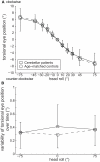Vestibulo-cerebellar disease impairs the central representation of self-orientation
- PMID: 21431098
- PMCID: PMC3049414
- DOI: 10.3389/fneur.2011.00011
Vestibulo-cerebellar disease impairs the central representation of self-orientation
Abstract
Transformation of head-fixed otolith signals into a space-fixed frame of reference is essential for perception of self-orientation and ocular motor control. In monkeys the nodulus and ventral uvula of the vestibulo-cerebellum facilitate this transformation by computing an internal estimate of direction of gravity. These experimental findings motivated the hypothesis that degeneration of the vestibulo-cerebellum in humans alter perceptual and ocular motor functions that rely on accurate estimates of gravity, such as subjective visual vertical (SVV), static ocular counterroll (OCR), and gravity-dependent modulation of vertical ocular drifts. We assessed the SVV, OCR, and spontaneous vertical ocular drifts in 12 patients with chronic vestibulo-cerebellar disease and in 10 controls. Substantially increased variability in estimated SVV was noted in the patients. Furthermore, gravity-dependent modulation of spontaneous vertical ocular drifts along the pitch plane was significantly (p < 0.05) larger in the patients. However, the gain and variability of static OCR and errors in SVV were not significantly different. In conclusion, in chronic vestibulo-cerebellar disease SVV and OCR remain intact except for an abnormal variability in the perception of verticality and impaired stabilization of gaze mediated by the otoliths. These findings suggest that OCR and perceived vertical are relatively independent from the cerebellum unless there is a cerebellar imbalance like an acute unilateral cerebellar stroke. The increased trial-to-trial SVV variability may be a general feature of cerebellar disease since a function of the cerebellum may be to compensate for such. SVV variability might be useful to monitor disease progression and treatment response in patients.
Keywords: cerebellar degeneration; ocular counterroll; otoliths; spontaneous vertical deviation; subjective visual vertical.
Figures


Similar articles
-
Head roll dependent variability of subjective visual vertical and ocular counterroll.Exp Brain Res. 2009 Jun;195(4):621-6. doi: 10.1007/s00221-009-1823-4. Epub 2009 May 5. Exp Brain Res. 2009. PMID: 19415246
-
Static ocular counterroll reflex in skew deviation.Neurology. 2011 Aug 16;77(7):638-44. doi: 10.1212/WNL.0b013e3182299f71. Epub 2011 Aug 3. Neurology. 2011. PMID: 21813791 Free PMC article.
-
Control of spatial orientation of the angular vestibulo-ocular reflex by the nodulus and uvula of the vestibulocerebellum.Ann N Y Acad Sci. 1999 May 28;871:94-122. doi: 10.1111/j.1749-6632.1999.tb09178.x. Ann N Y Acad Sci. 1999. PMID: 10372065
-
The interaction of otolith and proprioceptive information in the perception of verticality. The effects of labyrinthine and CNS disease.Ann N Y Acad Sci. 1999 May 28;871:324-33. doi: 10.1111/j.1749-6632.1999.tb09195.x. Ann N Y Acad Sci. 1999. PMID: 10372082 Review.
-
Perception of Verticality and Vestibular Disorders of Balance and Falls.Front Neurol. 2019 Apr 3;10:172. doi: 10.3389/fneur.2019.00172. eCollection 2019. Front Neurol. 2019. PMID: 31001184 Free PMC article. Review.
Cited by
-
Gravity-Dependent Modulation of Downbeat Nystagmus and Subjective Visual Vertical in the Roll Plane.Cerebellum. 2024 Oct;23(5):1899-1902. doi: 10.1007/s12311-024-01685-y. Epub 2024 Mar 18. Cerebellum. 2024. PMID: 38499815 Free PMC article.
-
Genetically eliminating Purkinje neuron GABAergic neurotransmission increases their response gain to vestibular motion.Proc Natl Acad Sci U S A. 2019 Feb 19;116(8):3245-3250. doi: 10.1073/pnas.1818819116. Epub 2019 Feb 5. Proc Natl Acad Sci U S A. 2019. PMID: 30723151 Free PMC article.
-
Function of bidirectional sensitivity in the otolith organs established by transcription factor Emx2.Nat Commun. 2022 Oct 24;13(1):6330. doi: 10.1038/s41467-022-33819-3. Nat Commun. 2022. PMID: 36280667 Free PMC article.
-
Cerebellum Involvement in Visuo-vestibular Interaction for the Perception of Gravitational Direction: A Repetitive Transcranial Magnetic Stimulation Study.eNeuro. 2025 Jul 30;12(7):ENEURO.0111-25.2025. doi: 10.1523/ENEURO.0111-25.2025. Print 2025 Jul. eNeuro. 2025. PMID: 40623832 Free PMC article.
-
Visual Perception of Heading in the Syndrome of Oculopalatal Tremor.Cerebellum. 2021 Oct;20(5):788-795. doi: 10.1007/s12311-020-01176-w. Cerebellum. 2021. PMID: 32740743
References
LinkOut - more resources
Full Text Sources

